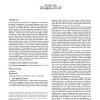Free Online Productivity Tools
i2Speak
i2Symbol
i2OCR
iTex2Img
iWeb2Print
iWeb2Shot
i2Type
iPdf2Split
iPdf2Merge
i2Bopomofo
i2Arabic
i2Style
i2Image
i2PDF
iLatex2Rtf
Sci2ools
KDD
2009
ACM
2009
ACM
Collaborative filtering with temporal dynamics
Customer preferences for products are drifting over time. Product perception and popularity are constantly changing as new selection emerges. Similarly, customer inclinations are evolving, leading them to ever redefine their taste. Thus, modeling temporal dynamics should be a key when designing recommender systems or general customer preference models. However, this raises unique challenges. Within the eco-system intersecting multiple products and customers, many different characteristics are shifting simultaneously, while many of them influence each other and often those shifts are delicate and associated with a few data instances. This distinguishes the problem from concept drift explorations, where mostly a single concept is tracked. Classical time-window or instancedecay approaches cannot work, as they lose too much signal when discarding data instances. A more sensitive approach is required, which can make better distinctions between transient effects and long term patterns. The ...
Concept Drift Explorations | Data Instances | Data Mining | KDD 2009 | Leading Collaborative Filtering |
| Added | 25 Nov 2009 |
| Updated | 25 Nov 2009 |
| Type | Conference |
| Year | 2009 |
| Where | KDD |
| Authors | Yehuda Koren |
Comments (0)

